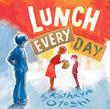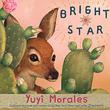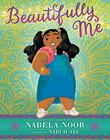Fall is nearly here, and with it an abundance of new picture books. Young readers’ editor Vicky Smith has already identified six that are especially timely; here Vicky and editor at large Megan Labrise ask some authors and illustrators about their books over email.
KATHRYN OTOSHI
In Kathryn Otoshi’s Lunch Every Day (KO Kids Books, Sept. 7), based on a true story, readers meet Jimmy, a bully who steals a classmate’s lunch daily rather than be seen eating free lunches. Crucially, Jimmy’s victim’s mother sees this too. Our reviewer says it’s “a sensitively told conversation starter.”
Did the pandemic affect this book?
There was definitely some hand-wringing involved in deciding on the release date! Ultimately, pushing it back a full year gave me the space I needed to evaluate my illustrations and consider how to use color more effectively. Instead of using natural skin tones for my characters, I used bright green, blue, red and purple hues for the students’ skin tones so the story wouldn’t be necessarily linked to a specific race or culture—[it’s] about economic disparity and Jimmy’s lunch-shaming experience.
If someone were to write and illustrate a formative moment in your life, who would you want it to be?
 When I was in elementary school, I watched another girl get severely bullied. [She] was the only other person at my school with Asian heritage. To this day, it still really bothers me that I didn’t do anything in her defense. While later I wrote and illustrated One, about standing up, if someone [else] were to make a story about this specific formative incident, I’d like it to be someone like [Jillian and Mariko Tamaki], who could address this painful experience with their instinctive sensitivity and grace.
When I was in elementary school, I watched another girl get severely bullied. [She] was the only other person at my school with Asian heritage. To this day, it still really bothers me that I didn’t do anything in her defense. While later I wrote and illustrated One, about standing up, if someone [else] were to make a story about this specific formative incident, I’d like it to be someone like [Jillian and Mariko Tamaki], who could address this painful experience with their instinctive sensitivity and grace.
What do you want kids to take from Lunch Every Day?
While we can’t always know what drives people to sometimes do hurtful things, the power of one small gesture can have an indelible impact. The mother of the boy who is bullied surprisingly offers to make a second bagged lunch for Jimmy. This transforms the situation…and ultimately changes Jim’s life. Jim Perez has helped hundreds of thousands of kids through his anti-bullying programs and community-building initiatives.
YUYI MORALES
In Bright Star (Neal Porter/Holiday House, Sept. 7), Yuyi Morales takes readers to the Sonoran Desert, where a mother deer greets her newborn fawn in the shadow of a wall. It’s a meditation “on community, imagination, immigration, and the natural world,” according to the Kirkus review.
How did the pandemic affect your process?
When quarantine was called, my world became this book. In July 2020 [my parents] got infected with Covid. I realized that I was creating with emotions like uncertainty that my parents might not survive, or anger at the hate inflicted upon the Asian American community, and frustration that the U.S.–Mexican border had been closed while people waited at detention facilities. I drew and painted and dedicated myself to honor [the urgency].
How did you choose a fawn as your central character?
 According to some ancient beliefs in Mexico, the deer [cares for] other animals. She is also the guardian of the mountains and is symbolized by the morning star. In the natural world, deer inhabit the borderlands. As I researched I learned how fawns are born without scent, [and] when a mother deer detects danger, they make their fawns lie down flat on the ground [and go] away to not attract attention. Do you know who else does this too? We humans do it [when] immigrant families try to protect their children from deportation.
According to some ancient beliefs in Mexico, the deer [cares for] other animals. She is also the guardian of the mountains and is symbolized by the morning star. In the natural world, deer inhabit the borderlands. As I researched I learned how fawns are born without scent, [and] when a mother deer detects danger, they make their fawns lie down flat on the ground [and go] away to not attract attention. Do you know who else does this too? We humans do it [when] immigrant families try to protect their children from deportation.
How did creating this book help you answer some questions?
This book, more than any other, is made from the many connections I made with people. One day [in] the Sonoran Desert, my friend [and research guide] Sergio Avila suggested that I might not find satisfying answers to my questions. “What,” he said, “if there is no single answer? Or the answer is that we sit near a pond like right now, and after we talk we get up and walk some more and we work, eat, serve, write, and draw, and still feeling our hurt we live every moment and we do all of this again and again?” And it was then when I felt I began finding a light.
NABELA NOOR
Beautifully Me (Simon and Schuster, Sept. 14) is Nabela Noor’s “spunky and sincere” debut picture book celebrating body positivity, with illustrations by Nabi H. Ali.
Who is Zubi, and how does it feel to be able to share her story with young readers?
Zubi is a joyful Bangladeshi American girl who discovers confidence in a world of narrowly defined beauty standard—all on her first day of school. She is curious, optimistic, bubbly and sees the beauty in all things around her. Sharing her story feels full circle for me, as a lot of what happens in the book stems from my own childhood experiences. I hope that this book serves as a reminder to all (children and adults) to be kind to yourself and to your body—not only for yourself, but because you never know who is watching and learning.
Were you a big reader as a kid? Did any books—or encouraging adults—especially influence you as a reader or writer?
 I grew up reading books with illustrations of kids and families that didn’t look like mine, bodies that didn’t resemble mine. I knew that I wanted to create a colorful, vibrant world that resembled my experience, with my language shining on the pages and our cultural attire and traditions celebrated from start to finish.
I grew up reading books with illustrations of kids and families that didn’t look like mine, bodies that didn’t resemble mine. I knew that I wanted to create a colorful, vibrant world that resembled my experience, with my language shining on the pages and our cultural attire and traditions celebrated from start to finish.
Growing up, I loved Junie B. Jones and Amelia Bedelia. I remember wishing I looked like those characters. Now I’m happy to share Zubi with the world and show young fellow brown girls that they’re beautiful just the way they are.
What fall release(s) are you most looking forward to reading?
I’m excited to read Norman Didn’t Do It! by Ryan T. Higgins, a story about friendship, Bright Brown Baby by Andrea Davis Pinkney and Brian Pinkney, a Black, Indigenous, People of Color–focused tale, and Eyes That Kiss in the Corners by Joanna and Dung Ho, another book that celebrates self-love and heritage.
Interviews by Vicky Smith and Megan Labrise



































